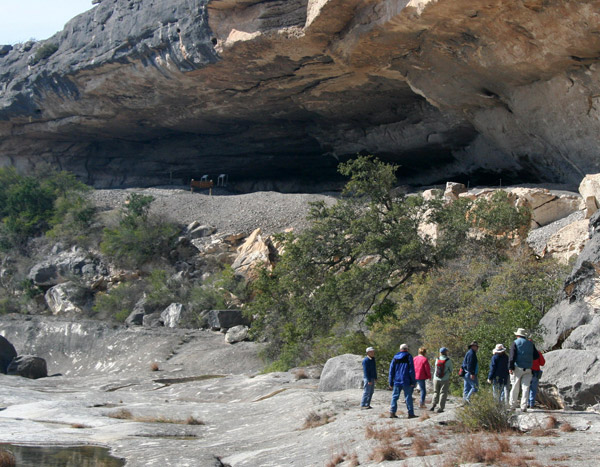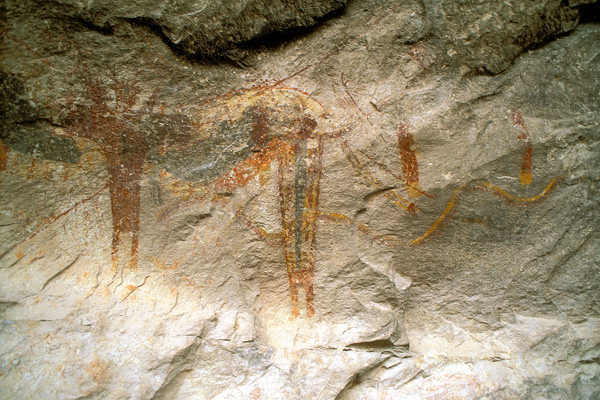Featured Park
Seminole Canyon State Park Offers Indian Rock Art, Camping, and More

In the geological span of time, human habitation in the Lower Pecos River Valley of southwest Texas is but a snapshot spanning the last 12,000 years, but oh what a colorful and mysterious period it's been.
Each year more than 60,000 visitors from all over the world find their way to the desolate, haunting environs of Seminole Canyon just north of the Texas-Mexico border. The main reason most visit the state park and historic site is to see the multi-hued and polychromatic blood red and black pictographs of shamans, animals and other fantastical figures decorating rock shelters and caves that Native Americans once called home some 4,000 years ago.
They marvel at rock art painted by nomadic peoples on limestone shelter walls and ceilings at several hundred pictograph sites where the Rio Grande and Devil's and Pecos Rivers merge into manmade Amistad Reservoir. One of the best and most accessible places to see the Indian paintings is Seminole Canyon State Park & Historic Site, a great midway stop on U.S. Highway 90 between San Antonio and Big Bend. Exhibits inside the Visitors Center help first-time visitors to this sere region better understand the area's unique natural and cultural resources.
"We even have the U. S. Border Patrol, National Park Service and other agencies bring their new employees out here to see the exhibits because they interpret 12,000 years of human habitation and provide a good background about the area," said Emmitt "Pancho" Brotherton, the park's longtime superintendent. "If you just drive through this area, you don't know what you're seeing. If you go through the exhibits and take the Fate Bell Shelter tour, you'll have a good feel for the area."
The Fate Bell Shelter tour leaves from the Visitor Center at 10 a.m. and 3 p.m. during cool-weather months. Participants must be in good enough physical shape to make the two-mile roundtrip from the canyon rim to the canyon floor and shelter 200 feet below. The 90-minute, guided rock art tours, often led by volunteers, also touch on ethno botany and geology. The Texas Parks and Wildlife Department recently erected wayside exhibits at the Visitor Center overlook and along the walkway in the Fate Bell Shelter to provide even better interpretation of the park's natural and cultural resources. The color panels help visitors better make out the fading pictographs that are being compromised by to the canyon's natural elements, such as humidity and wind-blown sand.
But prior to taking the tour, you may want to first familiarize yourself with the interpretive exhibit area's dioramas, historic photos and recreation of Panther Cave's rock art that walk visitors through time, from the Paleo-Indian era 12,000 years ago, through the Archaic Period, prehistoric and historic times up to the present-day ranching era. Here, too, can be seen dozens of artifacts excavated by state archeologists, such as ancient stones, bones, shells, hides and painted pebbles, the latter being unique to the Lower Pecos area.

One of the more interesting periods in the history of the Lower Pecos revolves around the coming of the Transcontinental Railroad in the 1880s. The steep, rugged Pecos River canyons proved the greatest challenge to railroad builders endeavoring to link the east and west coasts by rail. History tells how railroad workers used 500 kegs of blasting powder per mile to carve out two, 1,500-foot tunnels and 19th century engineering savvy to construct the Pecos High Bridge that spanned almost 3,000 feet over the 326-foot deep Pecos River chasm.
Brotherton says Seminole Canyon State Park & Historic Site is the only public place where a part of the historic Southern Pacific Railroad's roadbed is protected and still accessible. Look for the interpretive wayside exhibits inside the park pointing out the raised roadbed. In addition, on the road leading to the camping loop, stands a marker describing the limestone rock ruins of a bake oven used by Southern Pacific Railroad workers in 1882.
The 2,172-acre park also contains a watering hole and campsite used by the revered Seminole Negro Indian scouts, from which the park gets its name. Seminole scouts were hired by the U.S. military to track and fight the Comanche and Apache between 1872 and 1914. Both abandoned railroad sites and the Seminole watering hole can be seen during the park's half-day Upper Canyon tour. An all-day tour to five Indian rock art sites in Presa Canyon also can be arranged in advance.
The Seminoles, originally from Florida, were stationed after the Civil War at Fort Duncan in Eagle Pass and Fort Clark in Brackettville. From there, they conducted 26 missions against the Apache and Comanche warriors, fighting 12 battles, the most famous occurring just outside the park boundaries where the U.S. Highway 90 now crosses the Pecos. Remarkably, in all their combat with the Indians, no Seminole scout was ever killed or wounded.
But there's more than history to be enjoyed at Seminole Canyon. Motorists with ample time on their hands may want to camp a night or two. There are 23 water-electric campsites ($17 a night or $102 a week) and 8 water-only tent sites ($12 a night or $72 a week). A restroom with showers is readily accessible. Due to limited campground space, only a few large recreational vehicles can be accommodated. However, as more funds become available, the park plans to add 15 pull-through RV sites. Persons 13 and older pay a $3 park entry fee.
Hikers and mountain bikers, too, will find eight miles of multiuse trails winding through the rocky, desert scrub. The popular Rio Grande Trail leads to a picturesque overlook, where water from Lake Amistad backs up into Seminole Canyon. The half-mile Windmill Nature Trail that begins just outside the Visitors Center circles by sculptor Bill Worrell's bronze shaman, past a variety of Spanish-named desert flora and the remains of two windmills that bespeak the park's ranching heritage.
Seminole Canyon State Park & Historic Site is one of more than 90 recreational and historic sites that make up the Texas State Park System. Seminole Canyon is located on U.S. Highway 90 roughly 40 miles west of Del Rio, 9 miles west of Comstock and two miles east of the Pecos River Bridge. For more information, visit the Seminole Canyon State Park & Historic Site web site or call the park at (432) 292-4464. To learn about all of the Texas state parks, call (800) 792-1112, or visit the Texas Parks and Wildlife Web site.
 Texas Parks and Wildlife Department, 4200 Smith School Road, Austin, TX 78744
Texas Parks and Wildlife Department, 4200 Smith School Road, Austin, TX 78744


